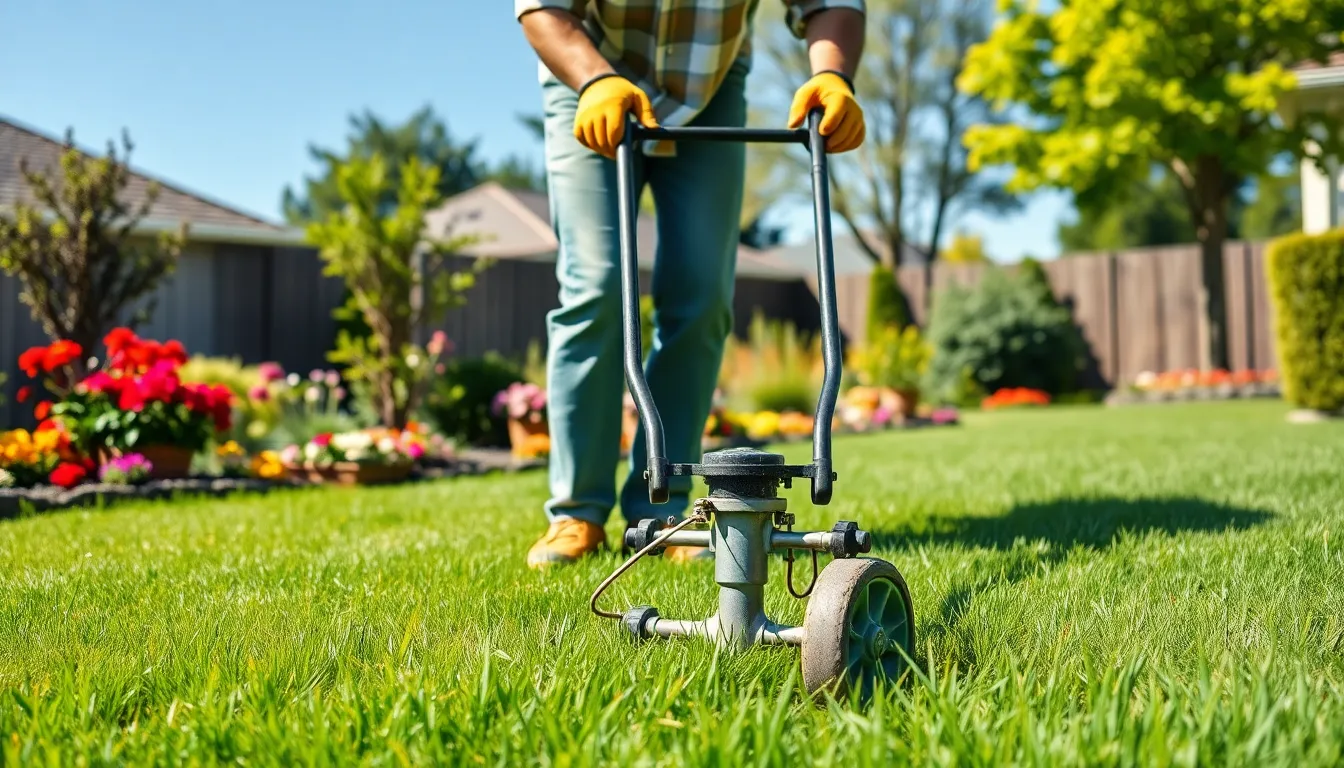A lush green lawn is a homeowner’s pride, but achieving that vibrant look requires more than just regular mowing and watering. Lawn aeration plays a crucial role in maintaining healthy grass by improving air, water, and nutrient flow to the roots. This simple yet effective process can transform a compacted, struggling lawn into a thriving oasis.
Many homeowners overlook aeration, assuming that their lawn will flourish without it. However, as soil compacts over time, it can hinder grass growth and lead to a host of problems, including poor drainage and increased susceptibility to pests. Understanding the benefits of lawn aeration can help homeowners take their lawns to the next level, ensuring they remain the envy of the neighborhood.
Table of Contents
ToggleWhat Is Lawn Aeration?
Lawn aeration refers to the process of perforating soil with holes to enhance air, water, and nutrient flow to grassroots. This essential practice improves soil structure and promotes a healthier, more resilient lawn.
Definition and Purpose
Lawn aeration involves creating small openings, typically with a core aerator, in the soil to reduce compaction. These holes allow essential elements to reach the roots more efficiently. The primary purpose of aeration is to alleviate dense soil conditions, facilitating a better growing environment for grass.
Importance for Lawn Health
Lawn aeration plays a crucial role in maintaining optimal lawn health. It promotes deeper root growth, enhances nutrient absorption, and improves drainage. Regular aeration helps prevent issues like thatch buildup, soil compaction, and poor moisture penetration. By aerating the lawn, homeowners can foster a more robust and vibrant lawn, minimizing susceptibility to pests, diseases, and environmental stressors.
Benefits of Lawn Aeration

Lawn aeration offers numerous advantages that contribute to a healthier lawn. Key benefits include improved soil compaction, enhanced nutrient absorption, and increased grass growth.
Improved Soil Compaction
Aeration alleviates soil compaction, allowing air, water, and nutrients to reach the grass roots more effectively. Compacted soil restricts root expansion and limits access to essential resources. By perforating the soil, aeration creates channels that relieve pressure, improving overall soil structure and promoting a thriving environment for grass.
Enhanced Nutrient Absorption
Aerated lawns experience enhanced nutrient absorption due to improved soil aeration. Fertilizers and organic matter penetrate deeper into the soil profile, making essential nutrients available to grass roots. This increased accessibility leads to robust growth and a vibrant lawn, as grass absorbs vital elements like nitrogen, phosphorus, and potassium more efficiently.
Increased Grass Growth
Lawn aeration results in increased grass growth through the promotion of deeper root systems. With better access to air and moisture, roots grow stronger and more extensive. This resilience enables the grass to withstand environmental stressors, such as drought and pests, leading to thicker, greener, and healthier turf. Regular aeration, therefore, significantly contributes to the overall vigor of the lawn.
Types of Lawn Aeration
Lawn aeration techniques vary, each designed to improve soil structure and promote healthy grass growth. The two primary types of lawn aeration are core aeration and spike aeration.
Core Aeration
Core aeration involves removing soil plugs from the lawn to enhance air and nutrient flow to the roots. This method uses a machine or a manual tool that extracts small cylindrical sections of soil, typically 0.5-0.75 inches in diameter and 2-4 inches long. The removal of these cores alleviates soil compaction, encourages deeper root growth, and enhances moisture absorption. Core aeration is particularly effective on clay-rich soils or lawns experiencing significant foot traffic. Regular core aeration, performed once or twice a year, boosts overall lawn health by improving drainage and reducing thatch buildup.
Spike Aeration
Spike aeration uses solid tines or spikes to create holes in the soil without removing any material. This method involves pushing the spikes into the ground to perforate the soil, increasing air circulation and allowing nutrients and water to penetrate more effectively. However, spike aeration can sometimes lead to soil compaction around the holes, making it less effective than core aeration for severely compacted lawns. This technique works best for lightly compacted soils or as a supplementary measure. Depending on the lawn’s condition, it can be performed as frequently as needed to maintain optimal health.
When to Aerate Your Lawn
Timing plays a crucial role in the effectiveness of lawn aeration. Homeowners should consider seasonal factors and visible signs to determine the best time for aerating.
Seasonal Considerations
Spring and fall remain the optimal seasons for lawn aeration. Spring aeration should occur after the last frost when grass begins to actively grow. This timing encourages quick recovery and increases nutrient availability. Fall aeration takes advantage of cooler temperatures and increased moisture, promoting root growth before winter. Performing aeration during these periods leads to healthier, more resilient grass.
Signs That Your Lawn Needs Aeration
Several indicators suggest a lawn requires aeration. Homeowners should look for:
- Soil compaction: Hard, compacted soil limits root growth and reduces nutrient absorption.
- Thatch buildup: A layer of thatch over 0.5 inches can prevent water and nutrients from reaching the grass roots.
- Poor drainage: Water pooling in certain areas signals restricted soil permeability, indicating a need for aeration.
- Surface roots: Visible roots suggest shallow root systems needing better access to air and nutrients.
- Declining grass health: Browning or thinning patches may signal compaction or poor nutrient uptake.
Taking note of these signs helps homeowners maintain a healthy and vibrant lawn.
Lawn aeration is a vital practice for anyone looking to cultivate a lush and healthy lawn. By prioritizing aeration, homeowners can significantly improve their lawn’s overall health and resilience. With proper timing and the right techniques, such as core or spike aeration, it’s possible to combat soil compaction and promote deeper root growth. Recognizing the signs that indicate a need for aeration can lead to a thriving lawn that stands out. Embracing this essential lawn care practice not only enhances the beauty of the yard but also contributes to its long-term vitality.



